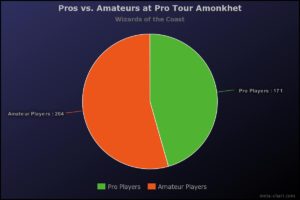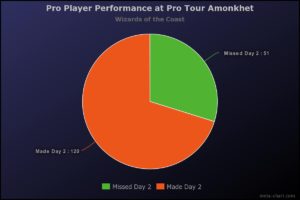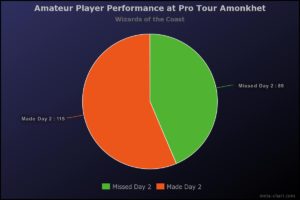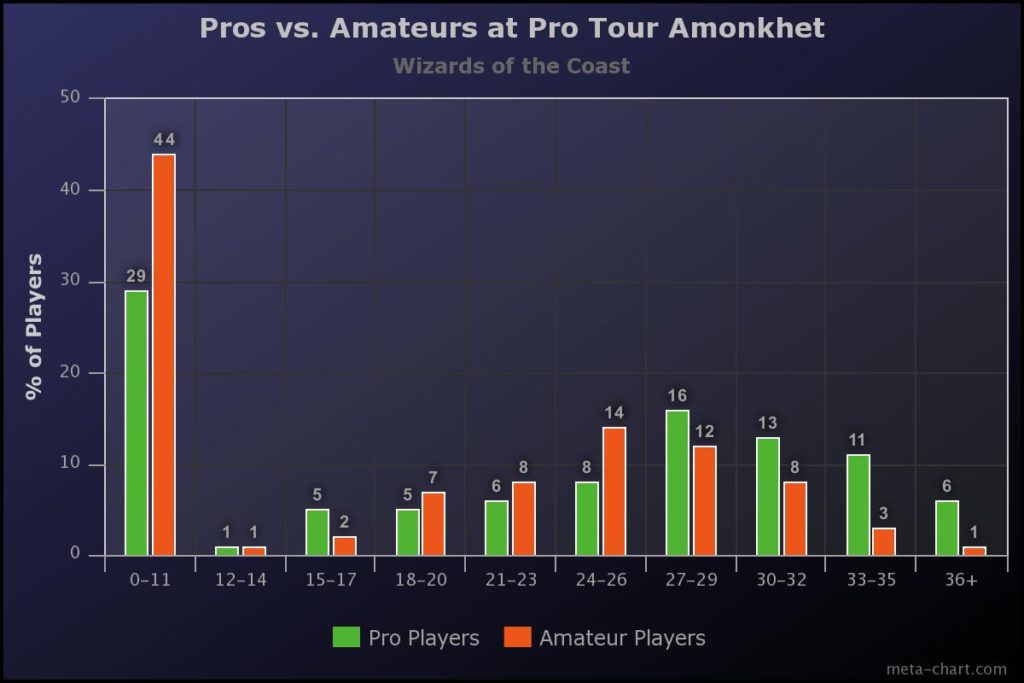We’re back with more analysis of the players who were invited to and subsequently competed at Pro Tour Amonkhet this past weekend in Nashville. Before we get started, make sure you check out last week’s column on how invitations were distributed to the Pro Tour. Once you’re caught up you’ll be ready to dive in here.
I’m a huge fan of analyzing data and the Pro Tour is a wealth of information about high-level Magic the Gathering. Coming off the heels of last week’s discussion of invitation sources, I had one question burning on my mind: do members of Pro Player Clubs perform better, on average, at the Pro Tour, than players who are not invited as members of clubs?
For the purpose of this analysis we’ll consider anyone who is in the Pro Tour Hall of Fame or anyone who had a Silver, Gold, or Platinum invitation to Pro Tour Amonkhet, even if they had other invitations as well, in the Pro Player Club Member category. Everyone else will fall into the Amateur Player category. The question is, who performed better in Nashville?
First off let’s look at the total distribution of the field. The exact numbers aren’t critical but we can see that Amateur players have a slight edge over Pro Players in total representation. That’s not terribly surprising given the large number of players who qualify through RPTQ and Grand Prix tournaments.
Our hypothesis is, simply put, that even though there are fewer Pro Players on the Pro Tour, there will be more of them represented at the higher ends of the tournament’s results, compared to the Amateur players who should be more prevalent in the bottom of the standings.
The simplest measure to make is to see how each group performed against the metric of qualifying for the second day of competition. In order to do so, a player must accumulate 12 match points on the first day of competition. This is most easily done by winning four matches, though three wins and three draws will also provide the requisite result. Two wins and six draws will also total 12 points, but is a highly unlikely result.
I think these two charts look best side-by-side so that we can see the drastic difference in performance among both groups. While less than half of each group missed out on day two of competition, it’s easy to see that a much more significant slice of the Amateur pool failed to accumulate the 12 match points needed for this benchmark.
In raw percentages, roughly 29% of Pro Players failed to qualify to play on Saturday at Pro Tour Amonkhet while 44%, almost double, of Amateur players failed to qualify. From this metric alone, if you were to question the quality of Pro Players vs. Amateur Players, it should be clear that the Pros are given that status for a good reason, and their performances, on average, back that up.
Lastly though, let’s dive into a more granular look at the field of players who do qualify for another eight rounds of high-level Magic competition. Does this trend hold true? Are the Pro Players who make day two still almost twice as likely to reach higher benchmarks than their amateur counterparts? Or, does the first barrier weed out poorer performing amateur players, leaving a more equal field?
What we have here is the percentage of each field that reached various match point barriers. The first group, on the far left, represents the players who failed to make it to the second day of competition. The next nine groups denote each additional win required to achieve the next plateau of match points. The final group, of 36 or more match points, was only achieved by 12 players and represents the most elite finishers at the event.
We can look at this in three different bands. The first spans 12 to 17 match points which may look in favor of pro players under-performing but I think it’s more accurate to chalk this up to small sample size. The next band is from 18 to 26 match points, roughly 6 to 8 wins in the event. Here we see amateur players have an edge over pro players.
Things change drastically when we pass the 27 match point barrier, as pro players start to significantly outperform amateur players. Once we get to the final few groups, the performance difference is staggering with pros more than three times as likely to finish in those groups.
Obviously this is only one tournament and the data is not robust in that it doesn’t necessarily have the best definition of pro versus amateur nor does it highlight things like quality of competition and it doesn’t differentiate between limited and constructed analysis. These are all worthy endeavors and we hope in time to build better analytics databases to produce that level of in-depth discussion.
In the meantime however, it seems clear that while amateur players outnumbered pro players at Pro Tour Amonkhet, the odds were much better for the pro players to finish higher in the standings. Is this because of team support? Is it because they’re simply more talented and/or more skilled? It’s likely a combination of many factors, a discussion for another time.
What We Learned is a weekly feature here at Hipsters of the Coast written by former amateur Magic Player Rich Stein, who came really close to making day two of a Grand Prix on several occasions. Each week we will take a look at the past seven days of major events, big news items, and community happenings so that you can keep up-to-date on all the latest and greatest Magic: the Gathering community news.





